The OWC Aura Pro X2 SSD Review: An NVMe Upgrade For Older Macs
by Billy Tallis on June 5, 2019 10:15 AM ESTAnandTech Storage Bench - The Destroyer
The Destroyer is an extremely long test replicating the access patterns of very IO-intensive desktop usage. A detailed breakdown can be found in this article. Like real-world usage, the drives do get the occasional break that allows for some background garbage collection and flushing caches, but those idle times are limited to 25ms so that it doesn't take all week to run the test. These AnandTech Storage Bench (ATSB) tests do not involve running the actual applications that generated the workloads, so the scores are relatively insensitive to changes in CPU performance and RAM from our new testbed, but the jump to a newer version of Windows and the newer storage drivers can have an impact.
We quantify performance on this test by reporting the drive's average data throughput, the average latency of the I/O operations, and the total energy used by the drive over the course of the test.
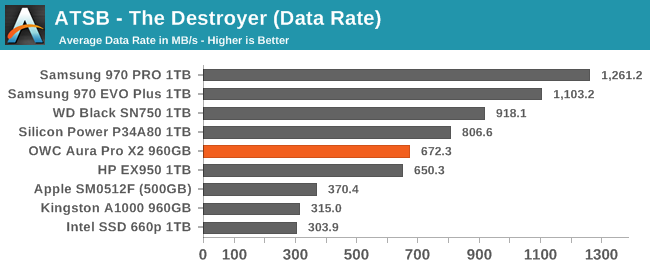
The OWC Aura Pro X2 performs about the same on The Destroyer as the other SM2262EN-based drive, the HP EX950. These are both fairly slow compared to other current high-end NVMe SSDs, but almost twice as fast as the early Apple PCIe SSD.
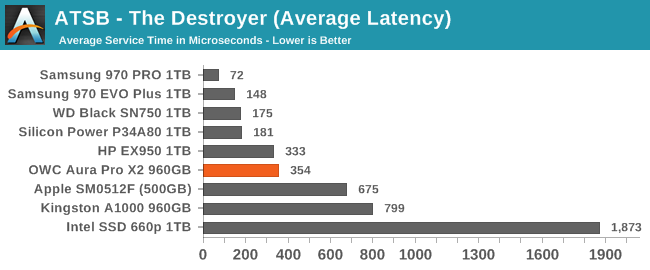
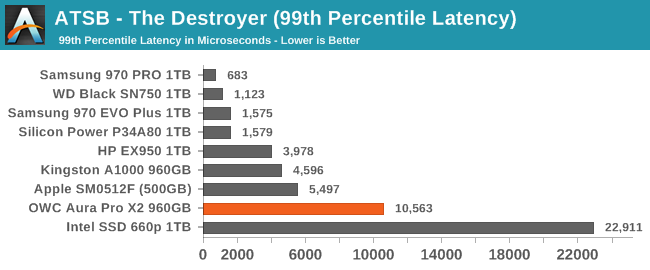
The average latency for the Aura Pro X2 on The Destroyer is in line with expectations, but the 99th percentile latency is far higher than the HP EX950 and the older Apple SSD.
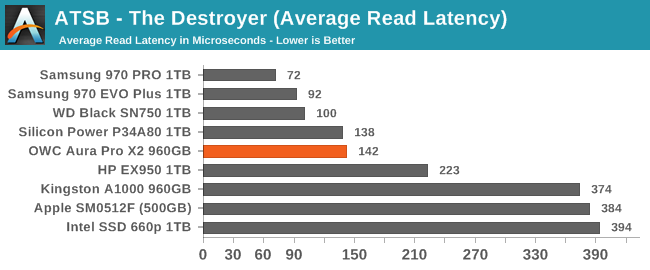
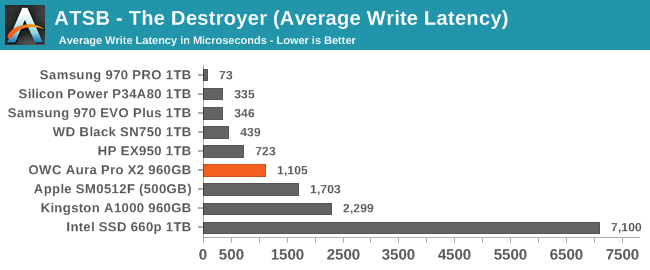
The OWC Aura Pro X2 shows more differences from the other SM2262EN drive when the average latency is broken down by reads and writes. For reads, the OWC drive is significantly faster than the HP EX950 and is comparable to the Phison E12-based Silicon Power drive. For writes, the OWC is slower than the EX950 but still well ahead of the Apple SSD and the current entry-level NVMe drives.
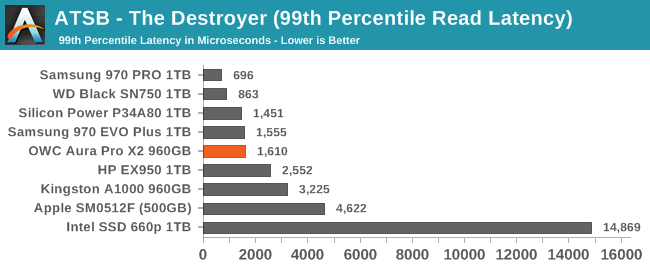
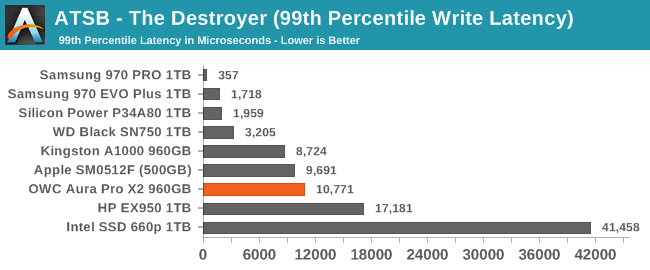
The 99th percentile read latency of the Aura Pro X2 on The Destroyer is competitive with other current high-end NVMe drives, but the 99th percentile write latency is a problem: it's a bit worse than the MLC-based Apple SSD, and several times higher than the best current TLC drives.
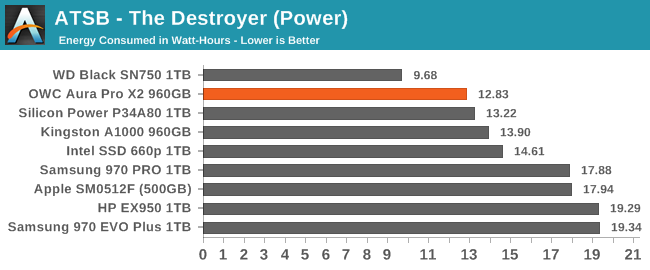
The OWC Aura Pro X2 is more power efficient than expected, using less energy to complete The Destroyer than most other drives in this batch, while the Apple SSD and the HP EX950 are some of the most power-hungry under load.










32 Comments
View All Comments
zepi - Wednesday, June 5, 2019 - link
Maybe you could list the Mac models that this works with in a nice table? It is not that long of a list.crimsonson - Wednesday, June 5, 2019 - link
Or you can go to the manufacturer's/seller's website and get the info?hasseb64 - Wednesday, June 5, 2019 - link
so why did you not post it here then?Ryan Smith - Thursday, June 6, 2019 - link
Hey, that's a good idea. Thanks! I've gone ahead and added a list.zepi - Thursday, June 6, 2019 - link
Thanks!I didn't even realise that this would actually be an upgrade path to my old rMBP13.
I wonder if the horrible mixed workload performance translate into a meaningfully slow zipping / unzipping performance.
leexgx - Monday, June 17, 2019 - link
maybe should add that its best not to even use these OWC ssds for these macs, as they have not fixed the power state bugs due to the mac it self (more so 2013-2015) and the SSD missing something proprietary (system has a high chance when it comes out of hibernate and crash as the drive is missing on wake up)ltcommanderdata - Wednesday, June 5, 2019 - link
https://forums.macrumors.com/threads/upgrading-201...Being a NVMe drive specifically designed to upgrade Macs, I don't suppose the OWC Aura Pro X2 solves the problem of NVMe drives failing to be detected upon wake from hibernation in 2013-2014 Macs? The current workarounds for that generation of Macs are to either disable hibernation reducing battery life or patching the BootRom which isn't user friendly.
It would have been interesting to see where Apple's Polaris NVMe drives stack up in your comparison since testing by @gilles_polysoft at Macrumors suggests it's still one of the fastest, most power efficient options compared to third-party SSDs. It was only offered officially in 2017 iMacs though so finding a pull or an Apple service provider willing to sell a new one to upgrade older Macs is difficult and expensive.
Skeptical123 - Wednesday, June 5, 2019 - link
That's a good pointzsero - Wednesday, June 5, 2019 - link
Yes, there is a big difference between 2013-2014 and 2015 Macbook Pros regarding how they work with NVMe drivers. After reading a _lot_ about it, I finally decided that for my 2013 rMBP 15 the best option is to buy an original "SSUBX" drive from eBay, as none of the NVMe drivers would work reliably.MamiyaOtaru - Thursday, June 6, 2019 - link
"I don't suppose the OWC Aura Pro X2 solves the problem of NVMe drives failing to be detected upon wake from hibernation in 2013-2014 Macs?"It does not. https://forums.macrumors.com/threads/owc-launches-... The OWC rep finally acknowledges it after mistakenly saying hibernation was fine for a couple pages. Disappointing lack of knowledge for the products he is shilling